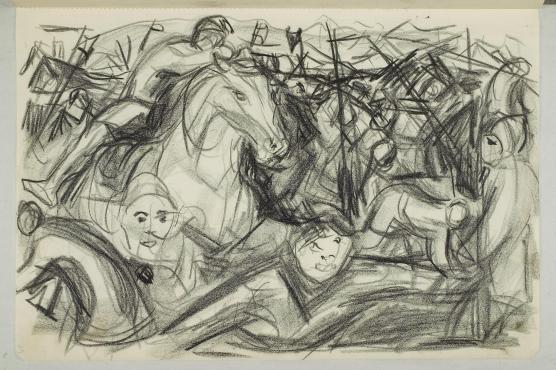
Throughout his life, Edvard Munch held the playwright Henrik Ibsen in very high esteem. Among his childhood drawings we find illustrations from The Pretenders, and in 1884 his sister Inger writes in her diary that she has borrowed Emperor and Galilean from the library for her brother who was ill in bed. And in 1895, when Ibsen made a public visit to Munch’s controversial exhibition in Kristiania, it made a great impression on the artist. “You will experience the same as I have”, Ibsen said to him, “the more enemies, the more friends.” When Ibsen published his last drama, When We Dead Awaken, in 1899, Munch claimed that he recognized his own motif Woman in the play’s three female characters.
Munch’s relationship to theatre was a close one. In Paris he made program posters for two Ibsen plays at Lugné Poës Théâtre de L`Oeuvre, and in 1906 – the year that Ibsen died – he made “mood sketches” for a production of Ghosts at the Deutsches Theater in Berlin (PE.M.00413b). The director Max Reinhardt also asked for Munch’s assistance the following year, for the production of Hedda Gabler.
A number of prints, a few paintings, and more than 350 drawings are registered as Ibsen-related. The relationship between Ibsen’s texts and Munch’s motifs is complex, from pure illustrations to more disputable “inspirations”. In many cases the characters are recognizable, either from real life or from Munch’s self-made world of motifs. The border line between the personal and the literary becomes vague, when Ibsen characters are infused with Munch’s own features. For instance, he identifies strongly with Osvald in Ghosts – he even describes his Frieze of Life as dominated by “a kind of Osvald mood”. The play Peer Gynt is a source for cheerful sketches (MM.T.00203-08), while motifs associated with The Pretenders are coloured by the atrocities of World War I.
Munch dwells upon several Ibsen characters: Rubek in When We Dead Awaken, Count Skule in The Pretenders, and – not least – John Gabriel Borkman in the play with the same name. In this case, the identification becomes particularly obvious (see i.e. MM.T.00246-02). The monumental Starry Night paintings may be regarded as a meaningful – but not compulsory! – context (see MM.T.02421).
(FH)
